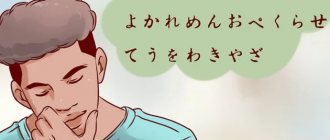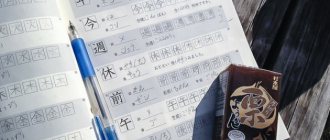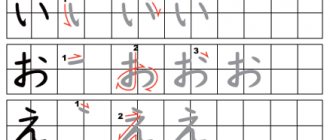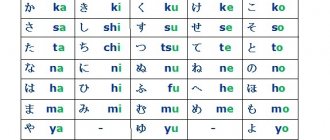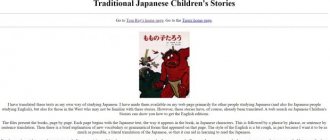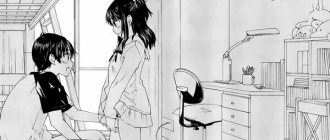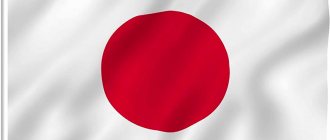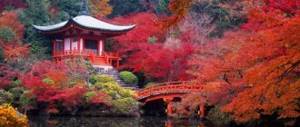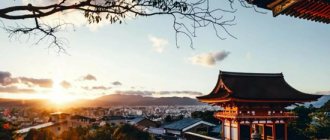Japan is a bright, colorful country that developed on a secluded island and was closed from the outside world for a long time. This explains why it is so different from other powers - even its neighbors. The culture of Japan was formed under Chinese influence, but what was borrowed was so thoroughly reworked and changed to suit the mentality of the island inhabitants that it is not easy, and sometimes impossible, to notice the kinship. Japanese symbols are one of the ways to understand the culture and characteristics of the population of the archipelago, to get to know the lifestyle, beliefs and ideas of people about beauty.
Land of the Sun
List of major characters of Japan
Any power has a set of symbols that characterize it. There are such ones in the Land of the Rising Sun. These are Japanese national signs and images associated with statehood, nature, culture and historical heritage. The most important ones are the coat of arms, the flag, and the anthem. For the citizens of the country, animals, flowers, cultural heritage and nature for which the country is famous are no less important. For foreigners, the symbols of Japan are often also katakana and hiragana - the syllabary alphabets of Japan. The islanders themselves do not consider writing to be a special symbol. Important features of the state include the raccoon dog, falcon, ibis, pheasant, stork, cat, cherry and chrysanthemum flowers, traditional dishes and dolls, Mount Fuji and samurai cultural heritage.
Symbols reflect the history of the state
Neck tattoo: Japanese characters
Japanese hieroglyphs for “god” and “devil”
Usually, tattoos with hieroglyphs are made in small sizes. Therefore, the neck is a place where these Asian symbols can often be seen. It is popular among girls because these tiny, neat tattoos on the neck or behind the ear look elegant.
Single hieroglyphs with beautiful meanings or whole small words are chosen as sketches; complex drawings in such a place are not very common.
Translation: “family”
Japanese letter "A" written in hiragana
Japanese characters for "idiot"
Official symbols of Japan
The state flower or animal of Japan are beautiful but unofficial symbols. The most important and significant are the signs that define an independent country. For Japan, the list includes the flag, coat of arms, anthem, and imperial seal.
Flag
In Japanese the flag is called "nisseki", but in everyday life it is called hinomaru - solar circle. The combined symbol has been in effect since the end of summer 1999. The history of hinomaru stretches back more than a millennium, but its meaning differed in different eras. In its modern form and meaning, hinomaru appeared when Japan decided to join the world community and began to follow the rules adopted in the field of international relations. The discovery of the country happened in 1867 and the government immediately realized the need to choose a symbol that would represent the country in the eyes of foreigners. In 1870, it was established that every ship should decorate a hinomaru. From this moment on, a red circle on a white background symbolizes the state.
Flag of the Land of the Rising Sun
During World War II, the meaning of the flag changed somewhat - the picture was associated with imperialism and militarism, the system that reigned in Japanese society at that time. In the powers that were at war with the Land of the Rising Sun, the sight of a red circle on a white background caused a violent reaction. With the end of the war, due to external pressure and economic demands, internal views changed, and the population actively discussed the topic of changing the flag. The country was rapidly developing in the sphere of politics, economics, and society; people were thirsty for change. At first, the disputes did not lead to anything; later the issue disappeared from public attention.
In the 90s, the question of what should be used as a flag was again raised. The discussion began with the question of whether it is necessary to raise the state symbol on a special day above educational institutions. It was decided that just like the written language, including kanji, and the anthem, the system of imperial government, which is symbolized by the personal seal, flag and coat of arms - signs that represent Japan, reflect the ideology of society, and therefore have every right to preserve and use . On August 13 of the last year of the last millennium, the Hinomaru was named the official Japanese flag, enacting the Flag and Anthem Law. It is still in effect today. The day the law was adopted became a holiday - flag day.
Hinomaru
The history of Hinomaru began in the distant past - approximately in the eighth century, so it was wrong to associate the red circle only with the militaristic stage of development. The picture is believed to depict the great victory of Emperor Jimmu, who achieved triumph in battle as the sun rose behind him. Gradually, the idea of the emperor as a child of the gods, a descendant of the sun, was formed. White and scarlet in Japanese religion are associated with life, purification and fire. The color of the flag is a symbol of pure life and perfect happiness.
Hymn
Every citizen of the Land of the Rising Sun knows the words of the Japanese anthem. When children begin writing in school, they will soon be able to write down the entire lyrics of the state song on their own. Even if a child only knows the alphabet, this is enough to understand, read and write the hymn - kids are taught this song from an early age. The official name of the symbol is cokka, but in everyday life it is called “Kimi ga e” (after the first line). The translation of the title is “The Reign of the Emperor.”
The Emperor is a descendant of the sun
The anthem in its modern form appeared during the Meiji period, when the country became an active participant in the international economic space. The song received its official status in 1888. The text is tanka from the Kokinshu poetry anthology, compiled in the 10th century. Thanks to this, the Japanese anthem, adopted at the official level later than in many developed powers, turned out to be the oldest in the world.
Translating tanka into Russian is very difficult - Japanese pentaverses contain many epithets, words are often used in a figurative meaning. Even a Japanese cannot always understand the meaning of what he reads the first time. This also applies to the anthem: difficulties arise already on the first line. If you look in the dictionary, you can find out that kimi is translated as “you”, but sometimes means the emperor. The whole phrase “Kimi ga e” is generally interpreted as a wish for a successful reign to the emperor.
Japan's national anthem praises the emperor
When the tanka, which later became an anthem, first appeared, it was recited and sung in a traditional style, completely different from the modern performance. Having chosen a quintet as the lyrics for the anthem, the Japanese worked hard to create music that was in harmony with the rhythm of the text, but consistent with Western traditions. The credit for creating the melody goes to Hayashi Hiromori, a man who served in the music department at the emperor's court. The finished melody was slightly changed by the military conductor Eckert. The final creation was presented to the public and sent to all countries with which the country maintained diplomatic relations.
Coat of arms
In most countries, the coat of arms is one of the key state symbols, but Japan is somewhat different - it does not exist here. The reason is that the European traditions of the coat of arms come from the Middle Ages, when each knight had a distinctive sign. In Japan there were no such features; the role of the coat of arms was played by the symbol of the ruling clan. Now the role of the coat of arms is played by the emblem of the emperor’s court - a chrysanthemum with a double row of 16 petals. Often, lovers of tattoos associated with the Land of the Rising Sun choose this theme to decorate their skin. Indeed, the flower looks complex, gentle, laconic and interesting at the same time. In Japan, the armorial chrysanthemum is called kikukamonse or kikkamonse.
Chrysanthemums
Imperial Seal
One of the official signs of the island power is the imperial seal Kiku no Gomon, which appeared during the Kamakura period and was already the privilege of emperors. The shape of the seal is a chrysanthemum with 16 petals. There is a circle in the center, the first row of petals is followed by the second. Gi-Toba is the first emperor to use the pattern as a personal seal. In 1869, the chrysanthemum became the symbol of the imperial house, and in 1871 a decree was issued prohibiting the use of the seal by persons other than the emperor. After World War II the ban was lifted. Relatives of the descendant of the sun had individual versions of the seal, where chrysanthemums have fewer petals - only 14. Now the seal is used in Shinto shrines, parliamentary premises, and diplomatic authorities. It is used by politicians to mark attributes. In addition, chrysanthemum adorns the cover of Japanese foreign passports.
Emperor's seal
Painting
Japanese painting was based on the principles developed in Ancient China: the system of genres, the ideological foundations of painting, symbolism and many other purely artistic means were borrowed from the continent at the same time as Buddhism. The system of genres was strikingly different from the European one. Even the most seemingly understandable landscape - in the tradition of the Far East - has its own characteristics.
What is Japanese landscape
Hattori Nankaku. Scenery. Edo period, no later than 1759 Wikimedia Commons
The main idea is hidden in the name: the Japanese word sansui and the Chinese shan shui translate as “mountains and waters.” This is not a portrait of some corner of nature, but the creation of an image of an ideal cosmic order, based on natural philosophy. Natural philosophical ideas also dictate the features of other genres - for example, “flowers and birds”, as well as “flowers and insects” and even decorative painting on screens, sliding partitions and walls.. Mountains and waters are a representation of the opposites that make up the driving force of the Universe. The masculine and feminine principles, the hard, unshakable and soft, changeable, light and dark (everything that adds up to a pair of yang and yin) are opposites that endlessly generate each other and are present in each other, forming the harmony of the universe, the reflection of which (and at the same time the statement) and this is the main task of the artist. The eastern landscape, as a rule, is speculative; it is the fruit of the desk work of an artist-thinker. Realism, similarity, and copying of nature, which became the basis of classical Western painting, did not have unconditional value for the Japanese.
How to read scrolls
The format of a horizontal or vertical scroll is related to the shape of a roll of silk, one of the earliest written media in the Far East. Paintings on silk or paper scrolls have no frame; there is no clear boundary between the image and the surrounding space. That is why the first Western collectors had an association with wallpaper. It turned out to be difficult for the European view to adapt to both the painting technique and the organization of space in the image. In classical Japanese painting, space is built using a special system of techniques. Clearly marked by details (buildings on the shore, boats on the water, etc.) or tonal accents, the compositional plans on vertical scrolls are easily stratified, often separated from each other by hazy stripes of emptiness. These pauses in the image and diagonal compositions help to slowly move from viewing the foreground to the distant ones, creating the effect of depth in the landscape.
Shugetsu. Landscape in Chinese style. No later than 1529 Honolulu Museum of Art
In horizontal scrolls, designed to be viewed slowly as one reads from right to left, this “temporal” aspect of painting is even more obvious. In the landscape of master Shugetsu, the viewer “enters” the image from the empty space of water and sky on the right side of the scroll, talks with poets and sages on the rocky shore, admires the old pine tree and “rises” into the gazebo, from where a view of the dark outline of gentle mountains opens up before him in the background, and then, deeper and higher, to the distant peaks of the third plane, shrouded in haze.
Why are houses shown without roofs?
The absence of scenes in enclosed spaces and city landscapes in the classical repertoire of Far Eastern painting made linear perspective irrelevant. And where it was necessary to adhere to strict geometric forms, imagination again came to the aid of both the artist and the viewer.
In Japanese Yamato-e painting from the Heian era (794–1185), the “interior with the roof removed” technique was used to depict scenes in palace chambers, when the artist and viewer looked at what was happening in the palace halls from above, as if looking into a doll’s house and seeing a fragment of the room with sloping beams, curtains and characters sitting in them.
Illustration for one of the chapters of “The Tale of Genji” by Murasaki Shikibu. Around 1130徳川美術館 (Tokugawa Art Museum)
This technique, which appeared in the 12th century in illustrated scrolls (the so-called emakimono), was later widely used in painting screens or movable fusuma partitions in palace and castle interiors. Japanese masters generally loved a bird's-eye view, which revealed to the audience a wide picture of festivals, military operations or city views. To emphasize this high point of view, the distance of objects and their separation from each other, the unkin technique was used. Clumps of trees, shown as if from above, or decorative gilded stylized clouds made it possible to divide the image plane into registers and plans. The term unkin itself is made up of the characters for "cloud" and "brocade": a reference to the lush clouds of cherry blossoms and the brocade of blushing autumn maples through which landscapes are shown.
Monk Yukinaga. Imperial procession to Ohara (illustration for “The Tale of the House of Taira”). Edo period, early 17th century The Metropolitan Museum of Art
The separated fragments of the imperial procession appear to be spaced apart, each with its own perspective. The artist follows the principle of “moving perspective”, when in one work there are many points of view and points of convergence of perspective.
Saen Hosai (Xiyua Fanqi). Myna on a plum branch. Edo period, 18th century The Metropolitan Museum of Art
As for modeling the volume of objects, the transitions from rich ink color to watercolor transparency were intended not so much to convey real light-and-shadow relationships, but to reveal the “backbone” of the form, which can inspire a sense of volume. And the pictorial background often completely disappears from the pictorial text, forcing the surface of paper or silk to work as an endless space.
Revered Animals
The traditions of Shinto explain why Japan has a special attitude towards animals and plants. The worldview of the inhabitants of the Land of the Rising Sun includes the worship of life and living things, which also explains the special, very careful attitude towards the flora and fauna of their native places.
Tanuki
A feature of Japanese folklore is the tanuki. This wonderful werewolf comes from the raccoon dog, common in the archipelago. The magical beast is a real prankster, possessing amazing qualities and capable of turning into people and objects. There are many tales about the fun of tanuki. They believe that a dog can become a teapot, turn into a monk, just to scare a person and have fun; but a werewolf figurine placed at home will bring happiness and drive away evil spirits. As a guardian of the home, tanuki are a source of well-being, prosperity, love, and numerous offspring.
It is not for nothing that the raccoon dog, from which the legends originate, is so beloved by the inhabitants of the archipelago. The eyes seem to be circled with black glasses, slightly slanted and reminiscent of a fox, so the animal’s face immediately captivates a person. Tanuki swim well, can climb trees, live in burrows, and are omnivores. They are not too fast, not very strong, but tenacious and resourceful, so they can always get food for themselves. A feature of the raccoon dog is hibernation, which is not characteristic of other species of the same genus. Even in the fall, the tanuki finds a companion for winter sleep, climbs into a hole in December and sleeps there until March. As soon as the thaw begins, the raccoon wakes up and goes hunting.
Japan is the only country where you can eat raccoon dog meat. Local residents consider it a delicacy and a powerful healing agent, and they use the fur to make brushes. Tanuki fat is a powerful folk medicine.
Raccoon dog
Taka
Taka is a term for falcons, although the word is often translated into Russian as “hawk.” The Japanese have paid special attention to the falcon family since prehistoric times. In the Middle Ages, samurai and aristocrats bred taka, and the bird’s image was used to decorate their coat of arms. The feather was a symbol of military valor and showed that a person belonged to a glorious family. Later, the taka image was used by families who did not have the right to their own mon. Gradually, love and respect for the bird became so deeply ingrained in Japanese life that the hawk became an unofficial symbol of the state.
Taka
Currents
The bird, called toki in Japan, is called the red-legged ibis in Russia. This is a beautiful white creature with a featherless red head and scarlet paws. Toki is massaged with an orb due to its color, which resembles a flag. Niigata has a special attitude towards the ibis - the province chose the feathered symbol. The traditional Japanese palette even includes the color tokaihiro, a shade of ibis feather.
Currents
Kinji:
One of the natural symbols of the archipelago is the green pheasant, which locals call kinji. The Japanese islands are the bird's natural habitat. The proposal to make the creature a symbol was made in 1947, put forward by the ornithological community. The reason for this choice is a strong maternal instinct, so the pheasant is associated with a strong, reliable family.
Green pheasant
The pheasant is attractive in appearance - it is brown-green, with a bright blue scarf of feathers, almost a meter long - but about half of it is in the tail. The bird's body weighs less than a kilogram. Female pheasants are smaller and not very brightly colored. Birds live in hills and bushes, herbs, and occasionally in parks and gardens. The green subspecies lives in the Japanese archipelago, Hawaii and North America, where it arrived from Japan.
Since the Middle Ages, the green pheasant has been a source of inspiration for poets of the Land of the Rising Sun. Nowadays the bird is a frequent participant in wedding ceremonies, as they believe that it will bring happiness to the couple and a long life together.
Japanese stork
The Japanese stork is a magnificent white bird with a red spot on its head, its color reminiscent of the flag of the Land of the Rising Sun. It symbolizes longevity and impeccable fidelity. The stork is a monogamous bird, choosing a single partner throughout its life. Tsuru often decorates wedding accessories and the newlyweds' chambers.
The story of the girl Sadako Sasaki, a victim of the atomic bomb, is connected with the Japanese stork. She was very sick, suffered and believed that life on the planet would become peaceful if she made a thousand paper storks. Death came before she finished her work, and then people from different parts of the country began to collect paper birds in memory of the victim of war and in the name of peace on earth.
Tsuru
Neko
There is a special attitude towards cats in Japan - in the capital there is even a temple where cats are revered. They believe that one day the samurai Ii Naotaka drove past the temple and saw a cat who seemed to be inviting him inside, washing himself and waving his paw invitingly. Naotaka did not pay attention to him and drove past, but a terrible downpour began. Ii returned to the cat to go into the temple, and at that moment lightning struck the place where he was standing a minute ago. The samurai hid in the monastery, realizing that the animal had saved his life, and donated a lot of money to the temple to restore the buildings. Today, thousands of porcelain figurines of maneki-neko, invoking happiness and warding off misfortune, await guests in this temple.
On February 22, the Japanese celebrate Cat Day. The choice of date is not accidental: 2-2-2 in Japanese sounds like “ne-nor-nor” and resembles a cat’s meow.
Japanese cat
Calligraphy
Hakuin Ekaku. Valor. Edo period, mid-18th century The Metropolitan Museum of Art
Almost all the principles of Far Eastern painting are in one way or another applicable to works of calligraphy - the art of beautiful writing. The first reason for this relationship lies in the commonality of materials and tools for writing and painting. Brush and ink, paper or silk, dictate the same features of visual language: the stroke that forms the outline of a mountain or the trunk of a bamboo is not much different from the stroke in the writing of a hieroglyph. In writing and painting, the artist's hand movements are the same. The master also regulates the thickness and brightness of a line or spot in the same way by pressing the brush, writing speed, and saturating the brush with water.
The second reason is the complex nature of the hieroglyph. The hieroglyph has a shape, color, compositional connection with the format of the work and other elements of the image. As a written sign that goes back to a pictogram - a schematized, simplified image of a real object - it retains a distant connection with the form of an object or natural phenomenon (and the hieroglyphs that denote stable natural forms remain the closest to a pictogram: mountain, water, fire, human and others) . As a sign of writing, it has a phonetic sound and meaning that is associated with a number of literary, religious or philosophical associations.
Handwriting systems: kaisho, gyosho and sosho
Six-door screen with calligraphy of Chinese poetry in the gyosho style. Japan, 19th century Naga Antiques Gallery
A calligrapher from the Far East creates a calligraphic work not just to capture the meaning, but to express and embody the idea of a single word, an entire poetic or prose work. At the same time, as a rule, it is bound by established forms of written characters: the basis of calligraphy is a system of handwriting, each of which has semantic nuances and corresponds to the author’s intention.
The neutral and easily readable kaisho style is closest to printed signs; “semi-cursive” (“running style”) gyosho is freer and more expressive, more dynamic and flexible: the movements of the brush are smoother and more united. But the greatest expressive potential is possessed by sosho, or “grass writing,” in which individual characters merge into smoothly curving lines, similar to tangled or creeping grass. The calligrapher shortens written characters by omitting or combining small elements.
Hon'ami Koetsu. Calligraphy of a poem from the collection "Shin kokin waka-shu", decorated with images of deer, in the sosho style. No later than 1637, MOA美術館 (Atami Art Museum)
Hieroglyphic writing came to Japan from China. To adapt it to the Japanese language, by the end of the first millennium, two syllabary alphabet - hiragana and katakana - were created, which complemented the hieroglyphic texts. Hiragana writing signs, often found in calligraphy along with hieroglyphs, constituted a special coherent creeping text, which in the work of the great 17th-century master Hon'ami Koetsu turns the lines of poetry into a continuation of the hanging shoots of ivy or grass and bushes in which deer graze.
Text, image and hieroglyph
1 / 2
Hakuin Ekaku. Two blind men cross a log bridge. Edo period, no later than 1768萬葉庵 The Manyo'an Collection of Japanese Art
2 / 2
Hakuin Ekaku. Hitomaro. Edo period, no later than 1768萬葉庵 The Manyo'an Collection of Japanese Art
Behind this most general classification of styles, or handwriting, there is a huge variety of author's variations. One sign can be written differently even by one master, since in each new case it will express a new idea and a new aspect of the phenomenon. It was the relationship between calligraphy and painting, the flexibility of Japanese writing, and the connection of calligraphy with literature and poetry that gave birth to unique Japanese synthetic genres. A haiga is a small pictorial sketch of a Japanese tercet with calligraphy. Zenga is calligraphy and painting of the Buddhist school of Zen, designed to express the essence of the teaching in a laconic and often paradoxical form. This synthesis is manifested in an organic and sometimes inventive combination of painting and calligraphy. Thus, the Zen artist Hakuin Ekaku (1685–1768) draws a log bridge spanning a stream as one horizontal line. His broad and smooth strokes, forming the outline of the clothes of the great poet Kakinomoto Hitomaro, are at the same time both an image and calligraphy, part of the text.
Sengai Gibon. Universe. No later than 1837出光美術館 (Idemitsu Art Museum)
The extravagant brushwork of Zen masters sometimes made the hieroglyph almost unreadable, and faith in the ability of the sign to convey the essence of complex philosophical ideas gave rise to seemingly modern art forms such as abstract painting. It is difficult to determine what type of art - painting or calligraphy - the famous scroll of Sengai Gibon (1750–1837), which received the conventional name “Universe” in the West, belongs to.
Mount Fuji
Volcano Fuji is a dominant feature of the Japanese landscape and the highest point in the country, raising its head to the sky at 3,776 meters. The volcano has existed for about 100,000 years and is now inactive. Fuji is the main natural symbol of the Land of the Rising Sun, an amazing miracle of nature and a revered shrine. Over the centuries, a spiritual connection between the local population and the beautiful volcano has been formed. It is known that the ascetic Hasegawa Kokuge climbed to the top of the mountain more than a hundred times, and his exploits made it possible to found the Fuji-ko sect, whose members worshiped the volcano. The tradition of deifying mountains continues today, and the spiritual importance of Fuji stands out especially strongly.
Approximately 300,000 pilgrims and tourists climb Mount Fuji every year. There are rest stations along the route, and the hike can be planned to watch the sunrise at the top of the mountain. The dominant landscape is attractive not only for those who want to strengthen their body and spirit, but also for creators - it has long inspired poets, prose writers, artists, and musicians. The most famous paintings date back to the Edo period and belong to the hand of Ando Hiroshige, and in the 19th century a series was published by the master of woodcuts Katsushika, which influenced not only ideas about beauty in his native country, but also the culture of Europe.
Mount Fuji
Tattoo on the leg: Japanese characters
Girls really like to get similar tattoos on their ankles, just above them or on their feet. On guys, they can often be seen on the calves as an element of a larger image.
Hieroglyph "love"
Japanese characters for "trust"
Japanese characters for the meaning of life
Japanese character "wave" tattoo
Japanese characters are a beautiful and mysterious decoration for the body. As with any tattoo, the choice of inscription must be approached carefully. We have shown several examples of Japanese character tattoos and their meanings. As you may have noticed, there are different styles in which these oriental symbols can be printed, from simple printed text to sweeping cursive calligraphy.
Would you get a tattoo of Japanese characters? If yes, which one? Write in the comments! 
Tattoo of Japanese characters with translation into Russian: their meaning and photo . The most popular tattoos with Japanese characters for women and men are in our article.
Cherry blossom and chrysanthemum
Flower viewing is a traditional Japanese holiday. There are several seasons: in the spring it is customary to look at cherries, at the beginning of summer - at wisteria, later at cosmos, and in the fall they admire chrysanthemums. Each season brings bright colors and a variety of shades, but there is only one dominant.
Decorative cherry is the most important flower of the Land of the Rising Sun. As early as the 8th century, imperial motorcades stopped along the way to enjoy the beauty of the trees in bloom. Over the millennia, sakura has been sung in many poems and recorded in paintings, engravings, and screens. Currently, several hundred varieties of decorative cherries are cultivated. Already a month before the start of the flowering season, a boom in products with cherry flavor or in the form of inflorescences begins in supermarkets, and on TV in the weather forecast, meteorologists report when to expect the first flowers, which region will be the first, how the wave of flowering will move across the country.
Blooming cherry
An equally important moment of the year is the period when chrysanthemums bloom, symbolizing the sun and the emperor. It is believed that one day the sky became very crowded, and several deities descended to earth via a cloud bridge. Among others came Izanagi and Izanami, who created the wind and the mountains, the sea and the winds. The goddess, having given birth to the god of fire, died, but her husband could not let go of his beloved and followed her into the kingdom of the night. Only by miracle did he manage to survive and return to earth, where he immediately went for a swim to cleanse himself. From the clothes he shed, 12 gods appeared, and his decorations became iris, lotus and chrysanthemum.
As a cultivated plant, chrysanthemum has been in particular fashion since the Edo period. Now the flower symbolizes the unity of the state and adorns the imperial seal. It is associated with the sun and the country's flag.
Japanese chrysanthemums
Dolls and Figurines
Japanese dolls are an important part of traditional culture. They are intended for special holidays, filled with sacred meaning, and participate in festivals and exhibitions. In the past, only sorcerers used dolls in rituals for healing the sick. Later, the Hinamatsuri holiday appeared, during which dolls symbolizing the imperial court are displayed on a special platform. When Hinamatsuri comes, the Japanese go to visit people to admire the puppet exhibitions of friends and acquaintances.
No less popular dolls are gogatsu-ninge, depicting samurai, heroes of legends, historical figures, and animals. They are used at the Tango no Sekku festival.
Autumn is the period when dolls are made from chrysanthemums and bamboo. They are exhibited at major events that attract guests from all over the world.
Hinamatsuri
Japanese characters: back tattoo
The back is a large part of the body. You can place an entire story with a large image on it, or a simple minimalist phrase printed on the spine.
Translation: “no matter what happens, I will overcome everything”
Translation: "phoenix"
Japanese characters for "love" and "happiness"
Circles symbolizing Zen are very popular.
Tattoo in calligraphic style
Guys often choose large drawings, complementing them with inscriptions in Japanese. These can be philosophical quotes, life mottos, poems.
And if you are one of those people who wants to get a tattoo with the name of a loved one in Japanese, then it will be written in katakana alphabet:
Caption: "Julia"
Legends
A peculiarity of Japanese culture is urban legends. Such stories are typical only for an island power, are not found in Europe, have a scary plot and tell about creatures that harm ordinary people. Urban legends come from traditional tales about ghosts and monsters. For a long time in Japan, stories have been told about youkai with unique features. It is these stories, modernized and complemented by modern surroundings, that have become urban legends.
Japanese folklore was formed under the influence of Buddhism and Shintoism, so some stories about evil spirits seem strange, even unpleasant, to a European. Zen Buddhism operates on the concept of purity of karma and the need to do good, despite difficulties. Another feature of urban legends is the principle of yugen, that is, the incompleteness of the story and the absence of key moments.
Arts and crafts
In Japanese applied art, deliberately modest, if not crude, objects coexist with defiantly luxurious things. Depending on the preferences of the Western viewer, the first can be regarded as a folk craft, interesting only in the ethnographic aspect, and the second - as the results of harmful external influences and an export style, the demand for which arose in the West after the Meiji Revolution. However, in fact, both are reflections of different aspects of Japanese culture and the diversity of aesthetic systems that coexist in Japan.
Ceramics
Shonyu. Tea bowl. Raku's workshop. Edo period. Around 1700 Pottery, black glaze.
Museum für Asiatische Kunst, Berlin The Japanese style in applied art today often means minimalism and laconic artistic language. Thanks to the popularization of the tea ceremony and ikebana in the West, such aesthetic categories of these arts as wabi - artlessness, unpretentiousness, even apparent rudeness, and sabi - the melancholy charm of antiquity, became known in the West. These ideas about beauty were expressed especially clearly in ceramics, and the works of the Raku workshop, which worked in Kyoto from the 16th century, are rightfully considered the standard of wabi in ceramics. The unpretentiousness of wabi tea ceramics is akin to the deliberate carelessness and roughness of Zenga painting: behind it there is a conscious idea of the essence of a thing and the content of the concept of “beauty”, elevated to an aesthetic and ethical ideal. For Zen adherents, a truly beautiful thing did not belong to the system of oppositions “beautiful - ugly”, but represented the indivisible, integral nature of the Buddha. For followers of the cha-no-yu tea ceremony, the objects involved in the tea ceremony, in addition to functionality and convenience, were supposed to be philosophical interlocutors.
Japanese ceramics - in the podcast “Why did I see this?”
How did ridiculous and crooked pots become national pride and a symbol of the country? And what ideas are behind them?
Shibuya and karei
1 / 2
Interior of a Japanese house in Shibuya style. Photo by Bernard Languillet. Yokohama, 2013 © Bernard Languillier
2 / 2
Box for papers in caray style. Azuchi-Momoyama period, early 17th century The Metropolitan Museum of Art
However, the principles of wabi and sabi emerged and had value in a limited social and intellectual circle and cannot represent Japanese aesthetics as a whole. Under the Ashikaga shoguns in the 13th century in Kyoto, the imperial capital of Japan, refined luxury was described by the word shibuya. This adjective, depending on the context, can be translated as “tart”, “muffled”, “subtle”, “tasteful” (the content of this “taste” was often compared to the taste of persimmon). By the 17th century, the beauty of Shibuya began to imply elegant restraint and nobility, the absence of eccentricity or vulgarity. This definition fits the interiors of a traditional Japanese home, where the color of old wood is combined with patinated metal details, and paper windows let in soft light without bright glare. In relation to a person, Shibui means “humble and dignified,” and the Shibui lifestyle implies the ability to enjoy simple things and see beauty in the world around us.
However, neither porcelain with polychrome painting, nor urushi lacquerware with gold decoration, nor bright kimonos and accessories fall under the definition of wabi and sabi or the restrained beauty of Shibuya. In contrast to this spirit of moderation, the concept of karei, “lush (blooming) beauty,” was used to describe the ceremonies of the Heian imperial court (794–1185) from the 9th century. Later, the ceremonial dress, the costumes of the Nogaku theater, gold screens, and varnishes corresponded to the idea of the luxury of the aristocracy and fell into the aesthetic category of karei.
Kabuku
Furuta Oribe. Tea bowl in the shape of a kutsugata (“crumpled shoe”). Azuchi-Momoyama period. Beginning of the 17th century The Metropolitan Museum of Art
Ideas about the lush beauty of karei and the calm elegance of shibui, despite the noticeable difference in content and visual embodiments with wabi and sabi, presupposed adherence to the norms of social behavior of their time. The philosopher and intellectual, striving for the ideal of the ancient sage, should have surrounded himself with things that were refined and restrained, while the aristocracy had to demonstrate the splendor of its position. At the same time, in Japanese art, including applied art, there is both grotesque and extravagance - everything that caused condemnation and indignation among educated Japanese.
One of the disturbers of aesthetic tranquility was the city kabuki theater, which emerged as a special theatrical genre at the beginning of the 17th century. The name itself carried a clearly negative assessment of what was happening on stage: it came from the Kabuku verb, meaning “to deviate, grimace, behave in a provocative and inappropriate manner.” Later, the name of the theater began to be written in other hieroglyphs so that the word could be read as “song, dance, skill,” but the concept of kabuku began to mean not only bright dynamic performances, but also a special style in the applied arts. Such a “deviation,” for example, was the tea utensils of Furuta Oribe (1544–1615), which were distinguished by exaggeratedly distorted and extravagant forms, contrasting color combinations, and flashy, intentionally rough decoration. This deliberateness was alien to the organic nature of the old tea utensils and sometimes caused condemnation. But Oribe created his designs in a different historical context than the founders of the Raku style, and the daring forms of his ceramics were equally shocking both for the tea masters of the wabi style and for the military aristocracy that was establishing the rule of the last dynasty of Tokugawa shoguns at that time.
Audio!
Course “Japanese Culture in Five Subjects”
Art critic Anna Egorova about why the Japanese sword is not a sword, how a screen saves from evil spirits and why everyone drinks tea from the same cup
Basara
1 / 4
Men's armor in the basara style. Japan, 18th century The Metropolitan Museum of Art
2 / 4
Kusama Yayoi. Work from the series “The Dream I Dreamed.” 2014 © 草間弥生 (Kusama Yayoi) / 예술의전당 (Seoul Arts Center)
3 / 4
Kusama Yayoi. Work from the series “The Dream I Dreamed.” 2014 © 草間弥生 (Kusama Yayoi) / 예술의전당 (Seoul Arts Center)
4 / 4
Takashi Murakami. "In 500 Arhats." © 村上隆 (Takashi Murakami) / Arthive
The desire for extravagance, or rather for a strong emotional impact, almost shocking and inspiring confusion, destroying all the aesthetic conventions of traditional Japanese society, guided many artists and artisans who created pictorial scrolls, samurai armor or items of military equipment.
In relation to such brutal, exalted external forms, the word basara was used, originally the name of one of the Twelve Heavenly Generals, deities of wrathful form guarding the throne of Buddha. Specialists and gallery owners tend to see basara aesthetics even in the works of contemporary Japanese artists, who rebel against any authority in art, the classical principles of painting, attracting marginal subjects and images, or creating kitsch. A striking example is Takashi Murakami, whose exhibition in Moscow caused a lot of discussion, or Kusama Yayoi, whose works in ceramics, installation and painting fit well into the basara system.
***
All these ideas about the meaning and function of art, about beauty are far from an exhaustive list of the principles underlying the art of Japan. To understand it, one must take into account not only the difference in aesthetic and artistic principles of East and West, but also the exceptional diversity within Japanese artistic culture itself - the close proximity to the continental cultures of China and Korea, the amazing ability to adapt external ideas, the complex syncretic worldview of the Japanese, the peculiarities of history and richness of mythological, folklore and literary traditions.
Is it possible to perceive Japanese art without having an idea of its foundations, history and language? Certainly. This is what happens to most viewers who admire Hokusai's prints or the lush embroidery on a kimono. But they discover, first of all, something of their own in Japanese art. Knowledge of the principles of creativity and perception, the original functions of works and technical features ultimately helps to comprehend the meaning that these works carried at their birth for the Japanese themselves. And this means getting closer to an adequate understanding of Japanese art.
watch our big video course about Japan
How to understand Japan
Alexander Meshcheryakov about the main Japanese symbols and how the attitude of the Japanese towards them changed under the influence of European civilization
Images: Utagawa Kuniyoshi. Engraving from the series “Famous views of the eastern capital”. 1834 LACMA
Sources
- Grisheleva L. D. Formation of Japanese national culture (end of the 16th - beginning of the 20th century).
M., 1986. - Nikolaeva N. S. Decorative art of Japan.
M., 1972. - Nikolaeva N. S. Japan - Europe.
Dialogue in art. Mid-16th – early 20th centuries. M., 1996. - Rowley J. Principles of Chinese painting.
Book of Insights. M., 1997. - Sokolov-Remizov S. N. Literature.
Calligraphy. Painting. M., 1985. - Uspensky M.V. From the history of Japanese art.
Digest of articles. St. Petersburg, 2004. - Graham PJ Japanese Design.
Tuttle Publishing, 2014. - Tsuji N. Lineage of Eccentrics Matabei to Kuniyoshi.
Kaikai Kiki Co., Ltd., 2012.
Tags
Cheat Sheet Painting
micro rubrics
Daily short content we've produced for the last three years
YouTube channel of the day
Philosophy for Beginners
Romance of the day
Shostakovich and English poets
Newsreel of the day
American soldiers watch a nuclear explosion in 1952
Archive
Literature
National cuisine
Japanese dishes differ from those familiar to Europeans because they are prepared, served, and served differently than in the rest of the world. These are usually simple, minimally processed foods. The task of a cook in Japan is to preserve the natural taste and natural appearance of food. For the Japanese, a meal is not just an everyday duty, but a real ritual that requires compliance with difficult rules of etiquette.
The main national dish is boiled rice. It is served with sauces, seasonings, and served in a separate bowl. Rice accompanies every meal.
Other traditional dishes:
- udon - noodles with additives and sauce;
- ramen - noodles in broth with vegetables or meat, seafood;
- sashimi – fresh seafood with seasonings;
- mochi - rice sweets with filling;
- onigiri are filled rice balls, often used as a snack.
Ramen
Samurai
The history of the samurai begins with the divine couple Izanagi and Izanami - they came to the islands via a sky bridge and began a military tradition that has governed many centuries of life on the archipelago. Samurai in Japan are a symbol of worldview, guardians of moral values, and the spiritual image of the country. The samurai class was formed in the 10th century, but sometimes it feels as if they have existed forever.
Samurai
The life of the samurai was governed by the code of bushido (the way of the warrior). The worldview is a harmony of militancy, learning and morality, determined by devotion, honesty, noble behavior and a dominant sense of duty.

